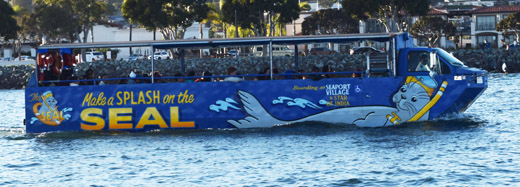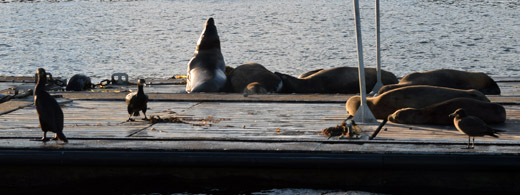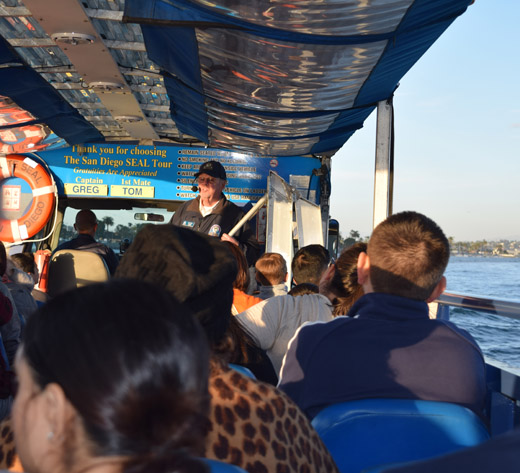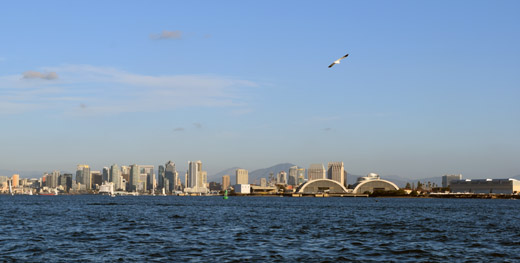
By Donald H. Harrison

SAN DIEGO – “Seal Tours” is the name that Old Town Trolley Tours of San Diego gives its sightseeing excursions in an amphibious vehicle on the waters of San Diego Bay and on land along the Embarcadero and Point Loma. That name might cause a bit of confusion because a mainstay of the tour is the sea lions – not seals – that have taken up occupancy on a large bait barge from which anchovies and sardines are sold by the bucket to anglers heading out to the Pacific Ocean.
Tom, the guide aboard our vehicle, explained that SEAL is an acronym for “Sea and Land.” He contrasted California Sea Lions with seals. “Sea Lions are bigger than seals , the males get up to 750 pounds,” he said over the loudspeaker. “Sea lions have ear flaps, seals don’t. Sea lions are smarter than seals; the Navy actually trains sea lions to help recover dummy torpedoes that Navy submarines have shot off. The sea lions have the mental capacity of a four-year-old (human) child; seals are just not smart. Sea lions have four large flippers; they can walk, run, and swim incredibly fast. Seals have four small flippers; they can’t walk or run at all, they just flop.”
The sea lions on the barge live in family groups, with each of the male sea lions having a “harem of about 5 to 6 females,” according to Tom. “These females stay pregnant almost their entire adult lives. The gestation period of each pregnancy is 11 months, and three weeks after a female delivers, she gets pregnant again. Her entire adult life ranges from 10 to 20 years, and during that she is pregnant every 11 months with a three-week break.”

Our amphibious boat motored past the barge one way, then turned around and motored past it in the opposite direction so that passengers on both sides could get a clear, unobstructed view.
“The sea lions are sleeping; they are like American teenagers,” Tom quipped. “They sleep 16-18 hours a day. They eat about 10 percent of their body weight, then go back and sleep.” The sea lions form themselves into a circle with adults around the perimeter and babies within “so it keeps them warm and safe.”
Sharing space on the barge with the sea lions are various sea birds, including black cormorants. Tom describes the cormorants admiringly. “Their feathers actually absorb water,” he said. “They can dive down to 100 feet to fish and when they come back up they are so waterlogged they have to stand out and dry in the sun before they can fly away.”
One reason that the bait barge, which looks like a floating dock, is so popular with the sea lions, cormorants, and other sea birds, is that “these animals will stick their heads and bills down the slats and steal the fish,” according to Tom.
One might quibble whether the bait company has any greater right than the sea birds and marine mammals have to the formerly free-swimming anchovies and sardines, but however many snacks the birds and sea lions purloin, there are plenty more. Many thousands of the little bait fish fill up a pair of 14-foot deep underwater cages.

We didn’t see any dolphins on this trip, but we certainly heard quite a bit about them. Just as the U.S. Navy trains sea lions to recover dummy torpedoes, so too does it employ dolphins to patrol San Diego Bay “looking for bad people.” Tom didn’t specify exactly what bad people might be doing that would attract the attention of a military-trained dolphin, but perhaps in matters of national defense, a bit of ambiguity goes a long way.
What Tom did tell us was that the “Navy has been training dolphins for 60 years; they have trained 120 dolphins.” These are not the dolphins you might see romping around in the Pacific Ocean; in fact, they are “Atlantic Dolphins which are smarter than Pacific Dolphins,” according to our guide. “There is nothing in the Pacific Ocean that dolphins can eat, so the Navy flies out food for them from the East Coast. … “
Besides having catered food, the dolphins have comprehensive medical care. “Even though this is a program run by the Navy,” says Tom, “the dolphins are cared for by Army veterinarians.”
The dolphins also have a dental plan, according to Tom. “Every couple of days they get their teeth brushed.”
Such VIP treatment for the dolphins has paid off. Tom says dolphins typically live between 7 and 9 years in the wild, whereas the life span of the Navy dolphins is between 20 and 25 years.
The Space and Naval Warfare Systems Command (SPAWAR) has jurisdiction over the training programs for the dolphins and sea lions. That Navy command also has cameras and radar stationed over the 14 ½ miles of San Diego Bay as part of its defenses against any possible intruder. San Diego Bay is home to two nuclear powered aircraft carriers and more than 50 other U.S. naval ships, most of which are berthed south of the San Diego-Coronado Bay Bridge. Along the north shore where the Seal boat goes is a submarine base at Ballast Point, home to six submarines and a drydock built especially for their repair. Nearby there is the Navy’s gas station, which fills up outbound Naval vessels using pumps that Tom says can output 6,000 gallons per minute. Eight tanks on the shore store a combined total of 42 million gallons of fuel, according to Tom.

Among the defenders of San Diego Bay and the Pacific Ocean is a “little gray boat with pontoons on the side” that Tom describes as a “submarine hunting boat. “
“When it goes out, it is totally autonomous; there are no humans aboard,” our guide informed. “It is run by somebody at a computer in one of these many buildings own here. The pontoons and the hull are made of carbon fiber invisible to radar.”
Old Town Trolley’s own fleet includes seven of the amphibious vehicles, three of which were on duty the winter day we took ours on a narrated tour from Seaport Village to Shelter Island, where it drove down a ramp and into the bay, later reversing course to return to Seaport Village, taking a total of 90 minutes. In the summer, all seven amphibious vehicles are utilized to help tell the story of San Diego’s sea life and Naval installations. Cost of the tour is $32 for adults; $25 for children between the ages of 3 and 12; and $10 for children under age 3.
*
Harrison is editor of San Diego Jewish World. He may be contacted via donald.harrison@sdjewishworld.com